The stars in tonight’s sky form many familiar patterns that make their host constellations easy to identify.
In the northern hemisphere, the brightest stars high overhead in the evening are Arcturus and Vega. In the southern hemisphere, Antares is near the zenith around 10 pm, while Rigil Kentaurus, Hadar, and the stars of the Southern Cross appear high above the southwestern horizon.
The stars visible tonight depend on the observer’s location and time of night. The star maps below show the first and second magnitude stars visible in the night sky around 10 pm in the mid-northern, equatorial, and mid-southern latitudes.
Northern hemisphere
The brightest stars in the sky around 10 pm are Arcturus, Vega, Altair, Antares, Spica, and Deneb. These stars appear high above the horizon in the evening. All are part of conspicuous asterisms that make them easy to identify.
Vega, Altair, and Deneb are the brightest stars in the constellations Lyra (the Harp), Aquila (the Eagle), and Cygnus (the Swan) and the fifth, 12th and 19th brightest stars in the sky, respectively. They form the Summer Triangle, an asterism that dominates the evening sky throughout the northern hemisphere summer. Vega and Altair appear bright because they lie close to the Sun. Vega lies 25.04 light-years away and Altair only 16.73 light-years away. Both are A-type main sequence stars hotter and more massive than the Sun. They are among the hotter stars in the solar neighbourhood.
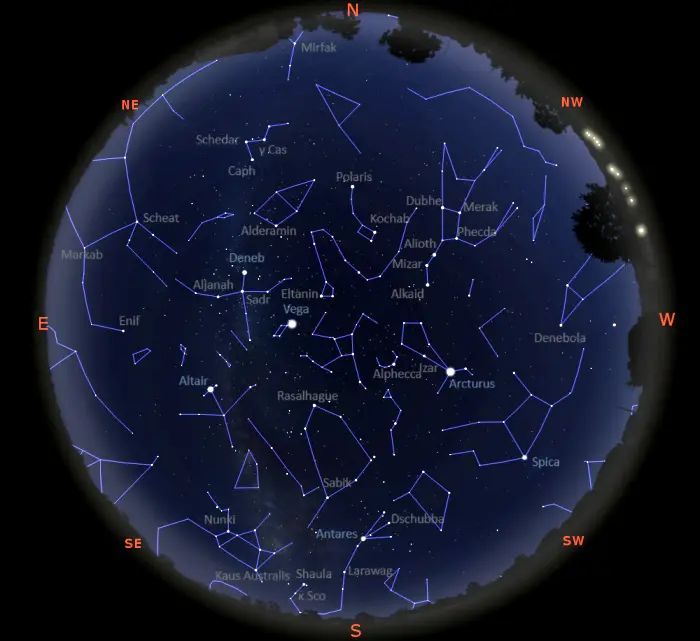
Stars visible tonight in the northern hemisphere, image: Stellarium
In contrast, Deneb is an evolved A-type supergiant and one of the brightest supernova candidates in the sky. It is by far the most distant first magnitude star, located 2,615 light-years away. It shines at magnitude 1.25 because it is intrinsically luminous. It has an energy output around 196,000 times that of the Sun. The supergiant marks the tail of the celestial Swan and the top of the Northern Cross, a bright asterism formed by the brightest stars in Cygnus.
Arcturus and Spica are the brightest stars in the constellations Boötes (the Herdsman) and Virgo (the Maiden). They form the Spring Triangle with Regulus in Leo and the Diamond of Virgo with Denebola at the Lion’s tail and Cor Caroli, the brightest star in Canes Venatici (the Hunting Dogs).
Arcturus and Spica can be found by following the arc of the Big Dipper’s handle. Arcturus is the first bright star along the imaginary curved line and Spica, the second. They form smaller asterisms with relatively bright stars in their host constellations. Arcturus appears at the base of the Kite, and Spica at the base of the Y of Virgo.
Antares, the brightest star in Scorpius, is part of the Fish Hook, a conspicuous southern asterism that forms the body, tail and stinger of the celestial Scorpion. For northern observers, the asterism appears in the southern sky and is particularly prominent during the month of July.
Northern sky
The brightest star appearing directly north is Polaris, the luminary of Ursa Minor (the Smaller Bear) and the 48th brightest star in the sky. Polaris is currently the North Star, the nearest visible star to the north celestial pole. The variable yellow supergiant marks the tip of the Little Bear’s tail and the end of the Little Dipper’s handle.
Unlike the Big Dipper, which is conspicuous in the northwestern sky, the Little Dipper is not easy to make out in light-polluted skies. Its middle four stars are relatively faint, and Polaris appears isolated in the sky. It can be found using the Pointer Stars, Merak and Dubhe, in Ursa Major (the Great Bear). A line extended from the outer stars of the Big Dipper’s bowl leads to the North Star.
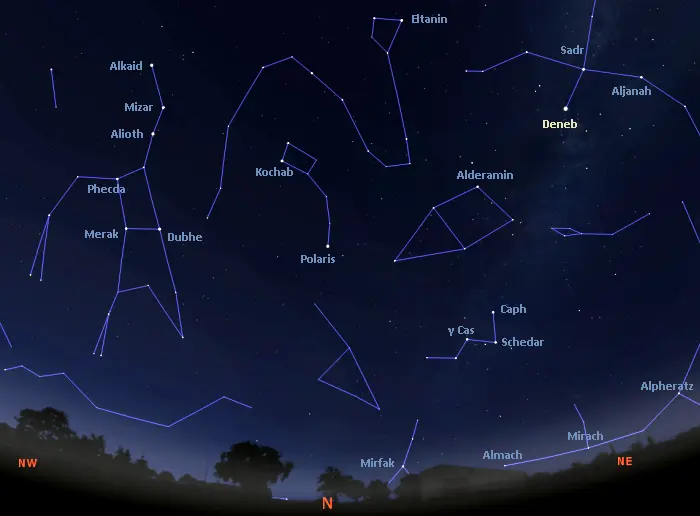
Stars in the northern sky tonight, image: Stellarium
Kochab and Pherkad, the outer stars of the Little Dipper’s bowl, are relatively bright and appear roughly parallel to Alioth and Mizar in the Big Dipper’s handle. They are known as the Guardians of the Pole because they circle close to Polaris and the northern celestial pole.
The Big Dipper is formed by six second-magnitude stars and the slightly fainter Megrez. The middle five stars are part of the same family, the Ursa Major association. These stars formed in the same molecular cloud at around the same time, and they travel together through space. All five are A-type stars located 79 – 84 light-years away. Mizar, Megrez and Phecda are still on the main sequence, while Merak is a subgiant and Alioth a giant or subgiant star.
Alkaid and Dubhe are more distant and are not members of the Ursa Major association. Alkaid is a hot B-type main sequence star and Dubhe is an orange giant. Alkaid is only about 10 million years old, while Dubhe has an estimated age of 280 million years.
The stars that form the body and tail of Draco appear between the Big and Little Dippers. They are visible on a clear night but do not stand out in the sky. Draco does not contain any first-magnitude stars. Eltanin is the only second-magnitude star in the constellation.
Eltanin and its neighbour Rastaban mark the Dragon’s eyes. They are part of an asterism that represents the Dragon’s head and can be found by extending a line through the beam of the Northern Cross in Cygnus (the Swan).
The five brightest stars of Cassiopeia (the Queen) stand out in the northeastern sky. They form a W pattern that makes the constellation easy to identify. Schedar and Caph, the rightmost stars of Cassiopeia’s W, point in the direction of Alderamin, the brightest star in Cepheus (the King).
The brightest stars of Andromeda (the Princess) and Perseus appear in a line low above the northern and northeastern horizon. Mirfak, the luminary of Perseus, can be found using the bright stars of Cassiopeia. It is the brightest star in the Alpha Persei Cluster, an open cluster visible to the unaided eye on a clear night.
The three brightest stars of Andromeda – Alpheratz, Mirach and Almach – form a chain between Perseus and Pegasus constellations. Alpheratz is part of the Great Square of Pegasus, an asterism that outlines the body of the celestial Winged Horse. Mirach, the middle of the three stars, can be used to find the Andromeda Galaxy (Messier 31) and the Triangulum Galaxy (Messier 33), the Milky Way’s close neighbours and the most distant objects visible to the unaided eye.
Eastern sky
The stars of the Summer Triangle – Deneb, Altair, and Vega – are high above the eastern horizon. Deneb and Altair are part of the constellation figures of the two celestial birds – Cygnus (the Swan) and Aquila (the Eagle) – that fly opposite each other in the night sky.
Deneb forms the Northern Cross with Sadr, Albireo, Aljanah and Fawaris, while Altair forms a smaller asterism called the Shaft of Aquila (or the Family of Aquila) with the fainter Tarazed and Alshain, the stars flanking it.
The Great Square of Pegasus rises in the northeastern sky in the evening, while Enif, the brightest star in Pegasus, appears high above the eastern horizon. Three vertices of the Great Square are visible around 10 pm: Alpheratz in Andromeda and Markab and Scheat in Pegasus. The fainter Algenib rises later in the evening.
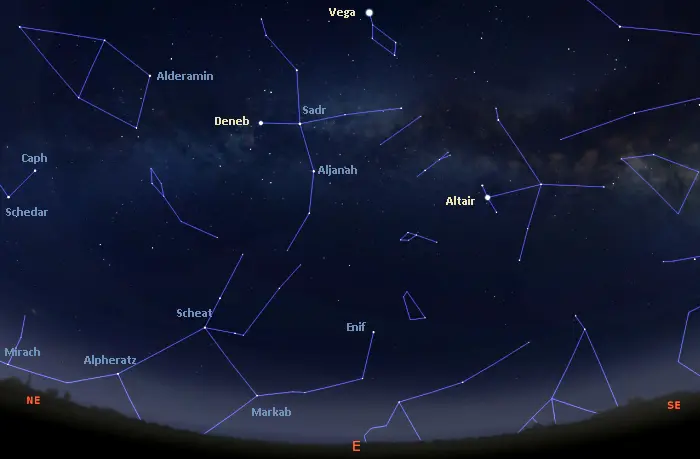
Stars in the eastern sky tonight, image: Stellarium
Enif forms an asterism called the Lightning Bolt with the brightest stars in the fainter constellations Aquarius (the Water Bearer) and Capricornus (the Sea Goat). The two zodiac constellations do not contain any stars brighter than third magnitude.
Western sky
The Diamond of Virgo, an asterism best seen during the spring months, sets early in the western sky in the summer, but can still be seen around 10 pm. It is formed by Arcturus in the constellation Boötes, Spica in Virgo, Denebola in Leo, and Cor Caroli in Canes Venatici.
Cor Caroli, the faintest of the four stars, shines at third magnitude below Alkaid in the Big Dipper’s handle. It is the prototype for a class of variable stars known as the Alpha2 Canum Venaticorum variables. The star’s brightness varies due to starspots coupled with the effect of rotation.
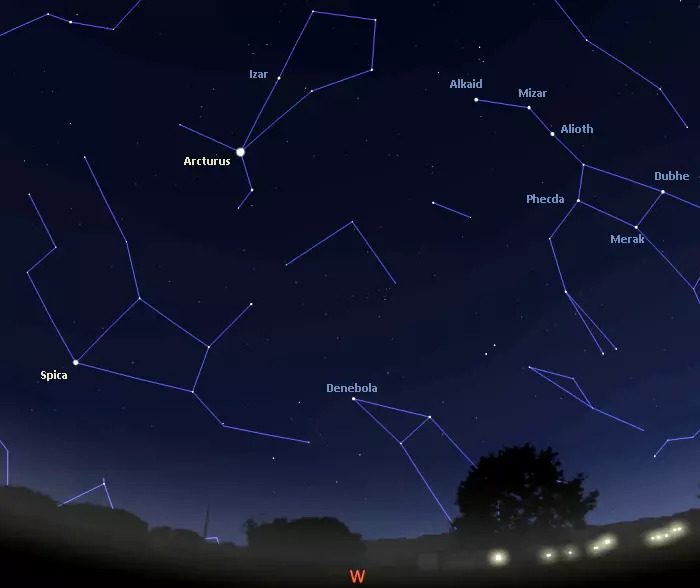
Stars in the western sky tonight, image: Stellarium
Arcturus and Spica can be found using the stars of the Big Dipper. Following the arc of the Big Dipper’s handle first leads to Arcturus and then to Spica.
Denebola, the star that marks the Lion’s tail, appears almost directly west. The rest of the constellation Leo may or may not be visible at 10 pm, depending on the location and geography. Regulus, the constellation’s brightest star, falls below the horizon earlier in the evening.
Southern sky
The stars of the zodiac constellations Sagittarius (the Archer) and Scorpius (the Scorpion) dominate the southern sky in the evening. The brightest stars in Sagittarius form the Teapot, an asterism that appears just left of the Milky Way’s bright band. On a very clear night, the Milky Way appears as steam coming from the Teapot’s spout.
Sagittarius contains two first-magnitude stars, Kaus Australis and Nunki. Kaus Australis marks the southern tip of the Archer’s bow. It is a binary star composed of a hot blue giant and a fainter young main sequence star. The more massive Nunki is also a B-type star, but unlike the brighter Kaus Australis, it is still on the main sequence.
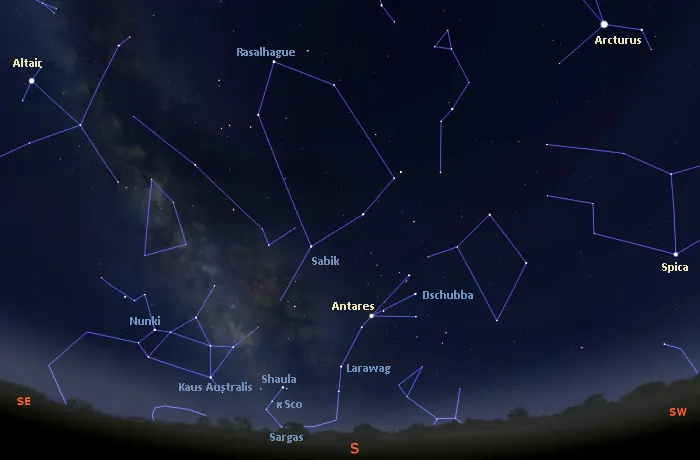
Stars in the southern sky tonight, image: Stellarium
The stars of Scorpius form two distinctive patterns – the Fish Hook and the Scorpion’s claws – that make the constellation one of the easiest to recognize. The red supergiant Antares, the 15th brightest star in the sky, marks the Scorpion’s heart and connects the two asterisms. Shaula and the fainter Lesath mark the Scorpion’s stinger and can be used to find two bright open clusters, the Butterfly Cluster (M6) and the Ptolemy Cluster (M7).
The brightest stars of Libra (the Scales) appear as the extended claws of the Scorpion. They are fainter than second magnitude but can easily be made out on a clear night. The constellation figure of Libra appears between the first-magnitude Antares in Scorpius and Spica in Virgo.
The brighter stars of Ophiuchus (the Serpent Bearer) form a large polygon in the sky. The A-type giant Rasalhague marks the head of the celestial Serpent Bearer. It lies roughly halfway between Vega and Antares. The fainter Sabik appears at the base of the polygon, near the Serpent’s tail.
Serpens is divided into two parts by Ophiuchus. The constellation’s brightest star, the K-type giant Unukalhai, appears in the neck of the Serpent and shines just below second magnitude.
Equatorial latitudes
For observers in the equatorial latitudes, the brightest stars visible high overhead around 10 pm are Altair and Antares, the luminaries of Aquila (the Eagle) and Scorpius (the Scorpion). Altair is part of the Summer Triangle, a bright asterism that dominates the evening sky from June to September. The bright Vega in the constellation Lyra and Deneb in Cygnus mark the other two vertices.
Antares is part of the Fish Hook of Scorpius, an asterism formed by the brightest stars of Scorpius. The Fish Hook outlines the body and tail of the celestial Scorpion.
Other first-magnitude stars visible in the evening are Fomalhaut in the constellation Piscis Austrinus (the Southern Fish), Arcturus in Boötes (the Herdsman), Spica in Virgo (the Maiden), Rigil Kentaurus and Hadar in Centaurus (the Centaur), and Acrux and Mimosa in Crux (the Southern Cross). These stars appear closer to the horizon.
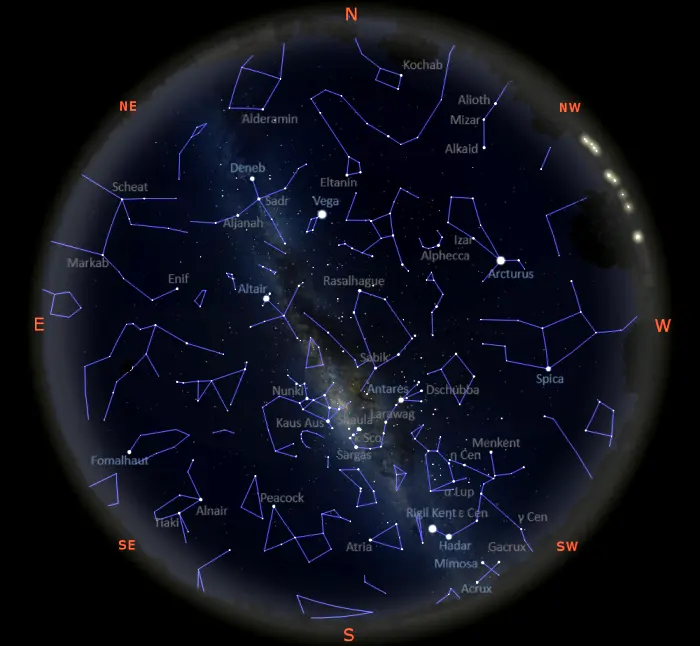
Stars visible tonight in equatorial latitudes, image: Stellarium
Northern sky
The brightest stars in the northern sky in the evening are Vega and Deneb. Vega, the brighter of the two, is the fifth brightest star in the sky. It shines at magnitude 0.026 from a distance of 25.04 light-years.
Unlike Vega, which appears so bright because it lies in the solar neighbourhood, Deneb appears bright because it is intrinsically luminous. The supergiant lies 2,615 light-years away and has an apparent magnitude of 1.25.
Deneb marks the tail of the celestial Swan and the top of the Northern Cross, an asterism that appears upside down when seen from equatorial and southern latitudes. Albireo, one of the finest visual double stars in the sky, appears at the base of the Cross and the brighter Sadr, Aljanah and Fawaris form the crossbeam.
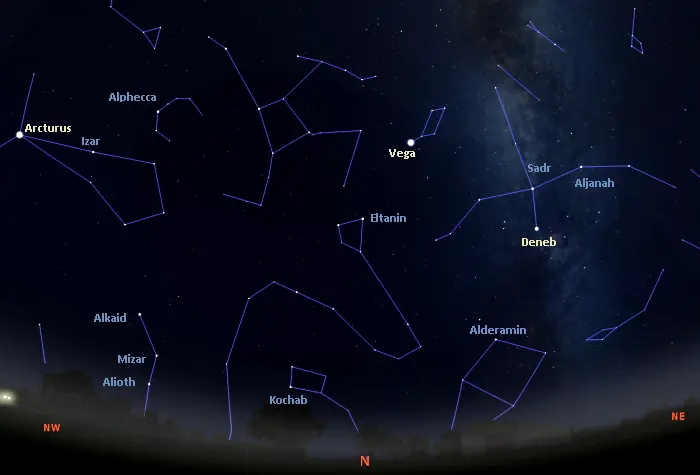
Stars in the northern sky tonight in equatorial latitudes, image: Stellarium
A line extended through the beam of the Northern Cross (or the wings of the Swan) leads to Eltanin and Rastaban in the constellation Draco. The two stars mark the celestial Dragon’s eyes and are part of a quadrilateral pattern that outlines its head.
Kochab and Pherkad, the Guardians of the Pole, appear low above the northern horizon. They form the Little Dipper with Polaris and several fainter stars in Ursa Minor. Polaris is mostly invisible from locations near the equator, but Kochab and Pherkad can be spotted close to the horizon since they are not as close to the north celestial pole as Polaris. The two stars appear parallel to Mizar and Alioth in the Big Dipper’s handle.
Alderamin, the brightest star in Cepheus, appears east of the two Little Dipper stars. It sits at the base of an asterism that looks like a stick house. The top of the house is marked by Errai further north and may not be visible from the southern equatorial latitudes.
Eastern sky
The brightest star in the eastern sky is Altair. Marking the Eagle’s head or neck, Altair is part of the bird-like pattern of Aquila. Shining at magnitude 0.76, it is the 12th brightest star in the sky.
The supergiant Enif, the brightest star in Pegasus, appears directly below Altair in the evening. It marks the muzzle of the mythical winged horse. The star’s name comes from the Arabic word for “nose.”
The fainter Scheat and Markab, the stars that mark the western vertices of the Great Square of Pegasus, appear closer to the horizon. The rest of the asterism rises later in the evening. The faint Circlet of Pisces appears close to it in the sky. The star pattern forms the head of the Western Fish of Pisces, but its stars are faint and difficult to spot in light-polluted skies.
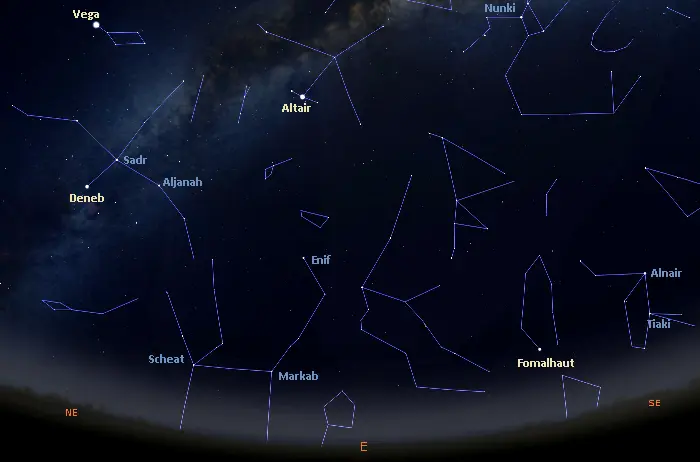
Stars in the eastern sky tonight in equatorial latitudes, image: Stellarium
A line extended through the western side of the Square of Pegasus leads to Fomalhaut, the brightest star in Piscis Austrinus (the Southern Fish) and the 18th brightest star in the sky. The star marks the mouth of the Southern Fish and shines at magnitude 1.16.
Alnair and Tiaki (Alpha and Beta Gruis), the brightest stars of Grus (the Crane) appear right of Fomalhaut in the southeastern sky in the evening. Alnair is a hot, blue, B-type main sequence star located approximately 101 light-years away and Tiaki is a red giant 177 light-years away.
Western sky
The brightest stars setting in the west in the evening are Arcturus and Spica. The luminaries of the constellations Boötes (the Herdsman) and Virgo shine at magnitudes -0.05 and 0.97 and are the fourth and 16th brightest stars in the sky. Both stars appear along the imaginary curved line extended from the three stars of the Big Dipper’s handle.
Arcturus is a K-type giant located 36.7 light-years away and Spica is a hot blue main sequence star 250 light-years away. Arcturus is 170 times more luminous than the Sun and Spica has an energy output of around 20,512 Suns. The two bright stars appear at the bases of two relatively bright asterisms, the Kite and the Y of Virgo. Alphecca, the brightest star of the Northern Crown (Corona Borealis), appears near the Kite.
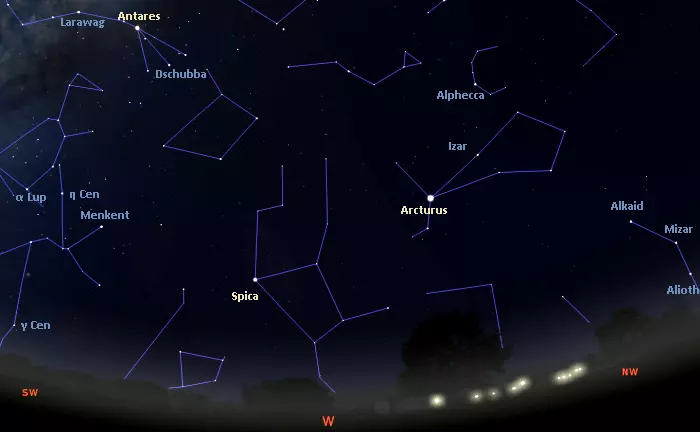
Stars in the western sky tonight in equatorial latitudes, image: Stellarium
The stars of the Big Dipper’s handle – Alkaid, Mizar, and Alioth – appear in the northwestern sky. They form the Great Bear’s tail. Alioth, the brightest star in Ursa Major, is an evolved A-type star with an apparent magnitude of 1.77. Mizar, the central star of the handle, forms a visual double star with the fainter Alcor. It is itself a quadruple star system with an apparent magnitude of 2.04. Alkaid, the star at the tip of the handle, is a hot blue main sequence star with a visual magnitude of 1.86.
Southern sky
The southern sky is populated by several bright constellations. Centaurus (the Centaur) dominates the southwestern sky. It hosts Alpha and Beta Centauri, the third and 11th brightest stars in the sky. Known by the proper names Rigil Kentaurus and Hadar, the two bright stars are known as the Southern Pointers. They point towards the Southern Cross, a bright asterism commonly used to find the south celestial pole.
Uridim (Alpha Lupi), the brightest star of Lupus (the Wolf), appears in the same area of the sky as the stars of Centaurus. The Southern Pointers can also be used to find Atria, the luminary of the constellation Triangulum Australe (the Southern Triangle). Atria is the brightest of the three stars that form the conspicuous triangle that gives the southern constellation its name. The star’s name is a contraction of its Bayer designation, Alpha Trianguli Australis.
The Southern Cross, the most distinctive asterism in the far southern sky, is partly visible in the southwestern sky in the evening. The asterism is featured on many national flags in the southern hemisphere. The diamond-shaped pattern is formed by Acrux (Alpha Crucis), Mimosa (Beta Crucis), Gacrux (Gamma Crucis), Imai (Delta Crucis), and Ginan (Epsilon Crucis). Acrux, Mimosa and Gacrux are the 13th, 20th and 25th brightest stars in the sky, respectively.
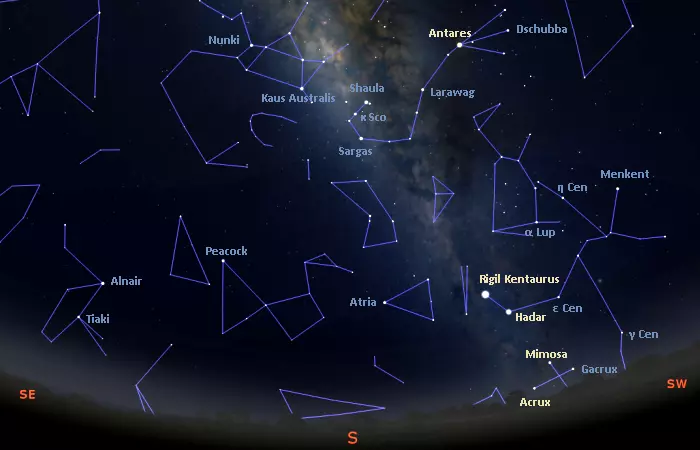
Stars in the southern sky tonight in equatorial latitudes, image: Stellarium
The zodiac constellations Sagittarius and Scorpius (the Archer and the Scorpion) appear high above the southern horizon. The brighter Scorpius hosts Antares, the 15th brightest star in the sky. The red supergiant marks the heart of the Scorpion and was historically also known as Cor Scorpii. It shines at magnitude 0.96 from a distance of 550 light-years.
Shaula, the second brightest star in Scorpius, marks the stinger with the fainter Lesath. Antares and Shaula are both part of a conspicuous asterism known as the Fish Hook. The star pattern outlines the body and tail of the celestial Scorpion.
Alnair and Tiaki in the constellation Grus (the Crane) are the only two second-magnitude stars in the southeastern sky. Grus is one of the four Southern Birds constellations, along with Toucana (the Toucan), Pavo (the Peacock), and Phoenix. Peacock (Alpha Pavonis), the brightest star in Pavo, is visible above the southern horizon. The stars of Tucana are partly visible low in the southeast, while Phoenix is below the horizon in the evening.
Southern hemisphere
The brightest stars visible from the southern hemisphere in the evening are Rigil Kentaurus, Arcturus, Vega, Achernar, Hadar, Altair, Acrux, Antares, Spica, Fomalhaut, and Mimosa. Antares, the luminary of the constellation Scorpius, and Rigil Kentaurus and Hadar in Centaurus appear high overhead in the evening, while the other first-magnitude stars are closer to the horizon.
Antares marks the Scorpion’s heart and is the brightest star in an asterism known as the Fish Hook. The asterism appears close to the Teapot in Sagittarius (the Archer) in the sky.
Rigil Kentaurus and its neighbour Hadar (Alpha and Beta Centauri), mark the feet of the Centaur. They are known as the Southern Pointers. A line extended from Alpha through Beta Centauri points towards Gacrux, the star at the top of the Southern Cross, a bright asterism that can be used to find true south.
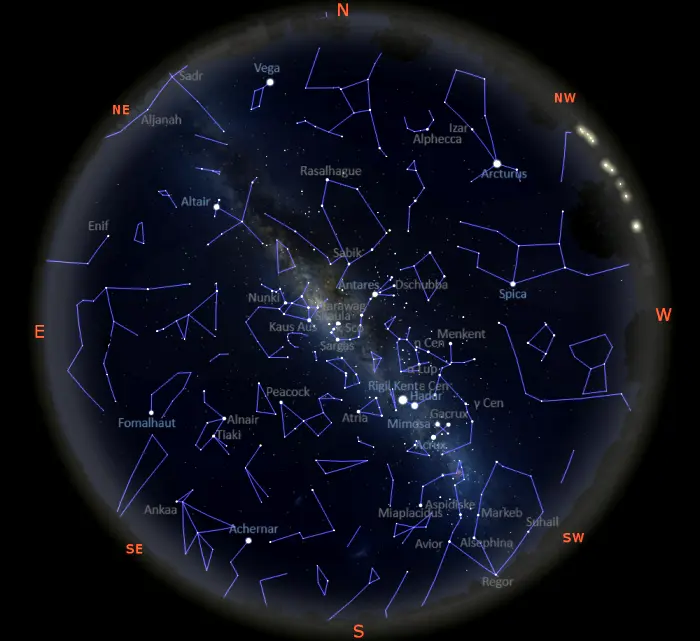
Stars visible tonight in the southern hemisphere, image: Stellarium
Northern sky
The brightest star in the northern sky is Vega, the lucida of the constellation Lyra. Vega is the fifth brightest star in the sky. It appears next to a small parallelogram pattern that forms the celestial Lyre.
Vega forms a large triangle with Altair in the constellation Aquila (the Eagle) and Deneb in Cygnus (the Swan). Altair is visible high in the northeastern sky, while Deneb is below the horizon around 10 pm.
The slightly brighter Arcturus forms an asterism popularly known as the Kite (or the Ice Cream Cone) with other bright stars in the constellation Boötes (the Herdsman). The giant star is the fourth brightest star in the sky and the brightest star in the northern celestial hemisphere.
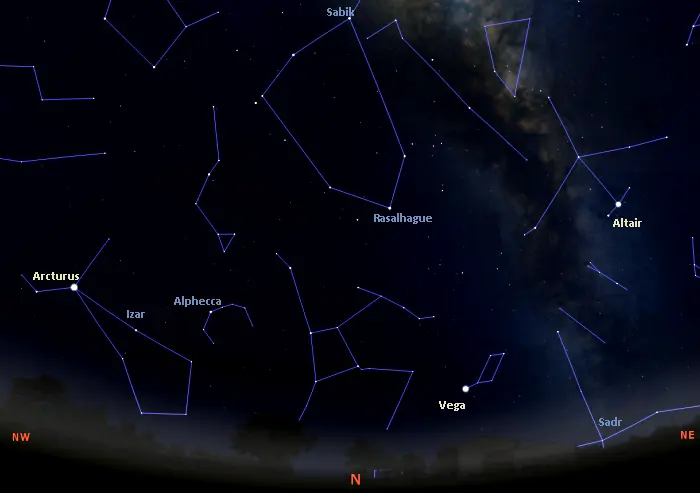
Stars in the northern sky tonight in the southern hemisphere, image: Stellarium
Izar, the constellation’s second brightest star, shines at second magnitude and is one of the best-known double stars in the sky. The bright Alphecca appears in the same area of the sky. It is the brightest star in Corona Borealis and marks the jewel in Crown of Ariadne.
The stars of Hercules appear between Arcturus and Vega. Even though it is one of the largest constellations in the sky, Hercules does not contain any first or second magnitude stars. It is recognizable for the Keystone asterism, a quadrilateral star pattern thar represents the torso of the mythical hero.
Rasalhague, the brightest star in Ophiuchus, can be found about halfway between Vega in the constellation Lyra and Antares in Scorpius. The white giant is part of a large polygon formed by the brightest stars in the Serpent Bearer constellation. With the exception of Sabik, the other stars are fainter than second magnitude.
Eastern sky
The stars of the faint constellations Capricornus (the Sea Goat) and Aquarius (the Water Bearer) lie directly east. The brightest stars of these constellations, the supergiants Sadalsuud and Sadalmelik in Aquarius and giant Deneb Algedi in Capricornus, form an asterism known as the Lightning Bolt with the supergiant Enif, the brightest star in Pegasus.
Altair, the 12th brightest star in the sky, appears high in the northeastern sky. It is part of a star pattern called the Shaft of Aquila. It forms the asterism with the two relatively bright stars flanking it, Tarazed and Alshain.
Fomalhaut, the 18th brightest star in the sky, stands out in the southern-southeastern sky, but appears isolated because there are no other first-magnitude stars in the vicinity. The fast-spinning star marks the mouth of the Southern Fish (Piscis Austrinus). On a clear night, the stream of stars representing water poured by Aquarius into the mouth of the Southern Fish can be spotted in the evening.
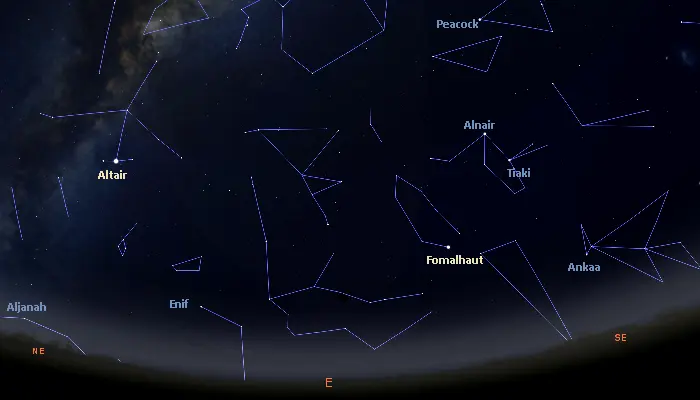
Stars in the eastern sky in the southern hemisphere, image: Stellarium
Several relatively bright stars appear in the southeastern sky. They belong to the constellations collectively known as the Southern Birds, Grus (the Crane), Phoenix (the Phoenix), Pavo (the Peacock), and Tucana (the Toucan).
Alnair, the brightest star in Grus, is a hot, blue, B-type main sequence star located 101 light-years away. It is 520 times more luminous than the Sun. Tiaki, the constellation’s second brightest star, is a red giant 177 light-years away, 2,500 times more luminous than the Sun.
Peacock, the lucida of Pavo, takes its name from its host constellation. The star appears directly above Alnair around 10 pm. It is a B-type main sequence star with an estimated age of 48 million years. It lies 179 light-years away and is 2,200 times more luminous than the Sun.
Ankaa, the luminary of Phoenix, is a K-type giant that shines with 83 solar luminosities. It lies 82 light-years away. The star’s name is derived from the Arabic word for “phoenix.”
The orange giant Alpha Tucanae, the lucida of Tucana, is a third magnitude star. It forms a triangle with Peacock and Alnair and appears high above Ankaa in the evening. the International Astronomical Union (IAU) formally named the star Lang-Exster in 2024.
Western sky
The brightest star in the western sky is Spica, the lucida of the zodiac constellation Virgo and the 16th brightest star in the sky. Spica can be identified using the brightest stars in Corvus (the Crow), which form an asterism known as Spica’s Spanker or the Sail. The northern side of the quadrilateral star pattern points towards Spica.
Arcturus, the fourth brightest star in the sky, appears lower in the northwestern sky. Shining at magnitude -0.05, the orange giant is the brightest star in the northern celestial hemisphere.
Centaurus, the ninth largest constellation in the sky, appears high in the western and southwestern sky. Its brightest stars, Rigil Kentaurus and Hadar (Alpha and Beta Centauri), point towards the Southern Cross, the best-known asterism in the southern hemisphere.
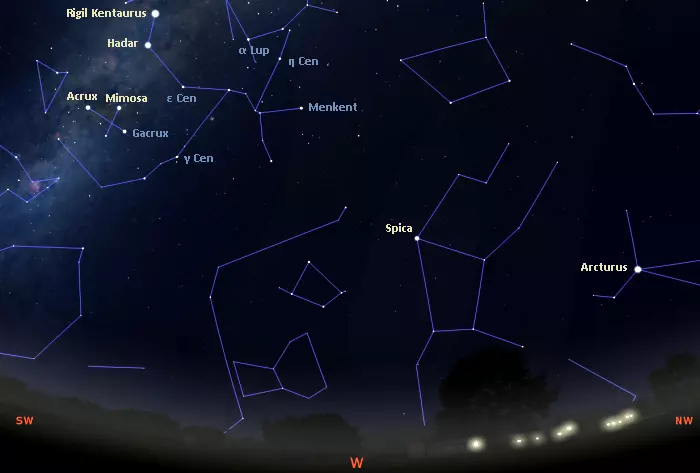
Stars in the western sky in the southern hemisphere, image: Stellarium
Southern sky
The stars of the Southern Cross appear high above the southwestern horizon. The three hot blue B-type stars in the group – Acrux, Mimosa, and Imai – are likely members of the same stellar family, the Lower Centaurus-Crux subgroup of the Scorpius-Centaurus association. They formed in the same place at around the same time and share a common proper motion through space. Gacrux, a red giant, and Ginan, an orange giant, do not belong to the same family.
Acrux and Mimosa are the 13th and 20th brightest stars in the sky. Both stars are supernova candidates, with masses 17.80 and 16 times that of the Sun. They shine with 25,000 and 34,000 solar luminosities and lie 320 and 280 light-years away. The second magnitude Gacrux is much closer to us. It lies 88.6 light-years away.
Achernar, the ninth brightest star in the sky, appears in the southeastern sky. The hot blue star marks the end of the celestial River (Eridanus). It is an exceptionally rapid spinner, with a projected rotational velocity of 250 km/s. As a result, it has the shape of an oblate spheroid. With an equatorial diameter 35% greater than its polar diameter, Achernar is the least spherical star known in our galaxy.
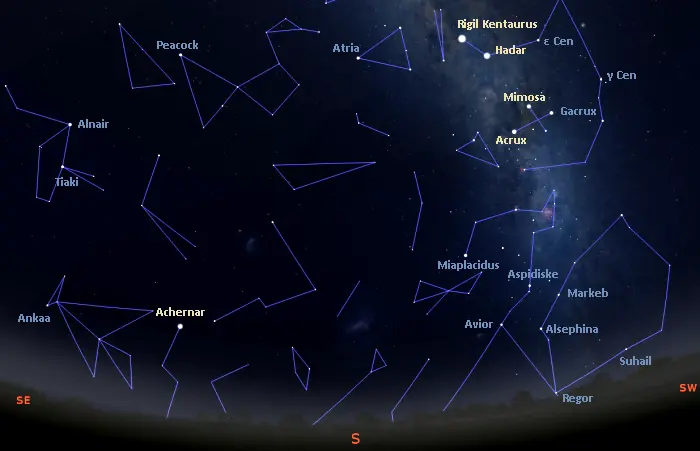
Stars in the southern sky in the southern hemisphere, image: Stellarium
The stars that once formed the constellation Argo Navis (the Ship Argo) and now belong to the constellations Carina (the Keel) and Vela (the Sails), appear below the Southern Cross. Avior and Aspidiske in Carina form an asterism known as the False Cross with Alsephina and Markeb in Vela. The asterism is often mistaken for the smaller and brighter Southern Cross.
Miaplacidus, the second brightest star in Carina (after Canopus), forms the fainter Diamond Cross with Theta, Upsilon and Omega Carinae.
The three diamond-shaped asterisms (the Southern Cross, False Cross and Diamond Cross) all appear in the southwestern sky. They can be used to find several well-known deep sky objects in this region of the sky. These include the Carina Nebula, the dark Coalsack Nebula, the globular cluster Omega Centauri (NGC 5139), the Wishing Well Cluster (NGC 3532), the Omicron Velorum Cluster (IC 2391), the Southern Pleiades (IC 2602), the Southern Beehive (NGC 2516), and the Lambda Centauri Nebula (IC 2944).